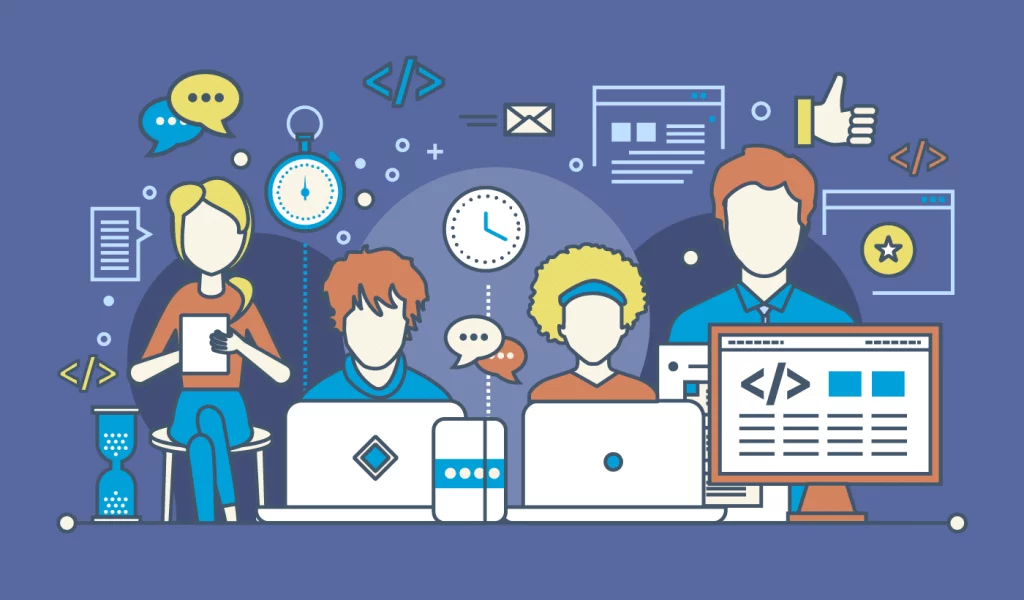With AI’s pervasiveness, it’s natural to wonder how it’s influencing the evolution of programming languages. When do we plan to arrive?
Imagine a world where computers don’t need programmers. This reads like the set-up to a science fiction scenario in which artificial intelligence ultimately triumphs over humankind. Despite how unbelievable it sounds, this day will come sooner than you think.
It’s no secret that A.I. has grown at an exponential rate over the past few decades, and that tendency doesn’t appear to be slowing down any time soon. The software development industry is no exception to the trend of AIs permeating nearly every sector of the economy.
Having access to robust integrated development environments (IDEs), liters, and method extractions has made our lives as software developers much simpler. They are all great instances of static solutions but imagine the possibilities if our tools could learn right with us. Suppose we had self-correcting code; how useful would that be? This is the hope for future programs thanks to artificial intelligence.
Software development is already being influenced by AI.
Incorporating robotic processes into the creation of software is not a novel concept. Bataresh and colleagues claim that AI has been essential in the software development life cycle (SDLC) since at least 1975. In software development, AI may help at every stage: requirements; design; development; testing; release; and maintenance.
The foundation of these tools is to generate algorithms based on a user-specified set of parameters, so even no-code solutions like Bubble can benefit from improved AIs. While the outcomes may be restrictive, artificial intelligence promises more responsive tools that can dynamically adapt and construct code with greater versatility.
Some of how AI may be relevant to the area of software engineering are addressed below.
Integrating requirements automation
The demands as specified by the client’s vision and the nature of the data serve as the foundation upon which software development projects are built. An application that retrieves data from a relational database is not the same as one that collects and processes unstructured data.
When it comes to obtaining data, AIs are a fantastic resource, making them a terrific complement at this phase. Consider the field of NLP (natural language processing). It might be used by an AI to assess software developers’ interviews with end users, highlighting phrases that can be used to foresee potential future features and obstacles.
Conversely, if the project requires a large quantity of unstructured data, it may be difficult for the developer to code for all conceivable outcomes, and it may be impossible to go over the data by hand.
If so, AI can analyze the data, classify it, and highlight any discrepancies that might become major problems later on.
Crafting Software
Coding is an essential part of every software development project, and any seasoned developer will tell you that it can be both rewarding and exasperating to work with code. There is nothing more frustrating than realizing after a failed compilation that you forgot a semicolon.
Artificial intelligence (AI) aided coding ideas are currently available in powerful IDEs like Visual Studio Code and PyCharm, providing instantaneous feedback to the developer about mistakes and recommending improvements to the code.
There are other add-ons available, such as Codota, that utilize deep learning to crawl the web in search of open-source projects from which they may learn code patterns. To put it plainly, the AI heuristically auto-completes the code by comparing it to patterns it has seen all across the web.
AI can also aid in the management of errors. It is common knowledge, for instance, that memory management in C++ can be a huge hassle for even the most seasoned programmers. Machine learning algorithms may simulate the code and make predictions about the program’s behavior, so helping to eliminate bugs like stack overflows.
When it comes to finding bugs in large chunks of code, trained AIs can outperform even the most skilled programmers. As they work toward completion, they may verify that the code conforms to a standard syntax, compare it to existing code guides, examine system logs, and highlight any problems they find.
As a result, programmers of the future will hopefully have access to smart assistants that can not only identify problematic areas of code but also rewrite or refactor it until the best possible solution is found.
Your program has to be tested.
Like a sewer pipe, unit testing is something no one particularly enjoys, but everyone knows is necessary. While creating software, no programmer can anticipate every possible circumstance. A flaw will be left unfixed until the rarest of circumstances calls for it to be fixed.
We can only be so cautious, after all, and ready for everything that could happen. Because of the time commitment involved in developing and running tests, some programmers practice defensive coding by designing their software to handle the worst possible case.
In a blink of an eye, AIs can perform millions of tests, and they can either use brute force testing to attempt every possible combination of inputs and outputs until the program crashes, or they can use more sophisticated methods. They can heuristically identify out-of-the-ordinary actions, and then design tests to account for those.
As we’ve mentioned before, the software may become self-sustaining with enough development, picking up on test results and rewriting itself to fix defects and minimize downtime.
Behavior forecasting
Amazon Web Services and Microsoft Azure both include cost forecasting tools. Your software’s processing power requirements and associated costs may be roughly estimated using a few elementary parameters.
More accurate budgeting is possible with the use of similar technologies. If you’re developing a web app and you know your user base’s traffic patterns, you can estimate the amount of bandwidth you’ll require each month with reasonable accuracy.
AIs also excel at predictive scheduling. Imagine having an AI that takes care of disk balancing automatically or a helper that can monitor your infrastructure and tell you when you need to scale or when you need to reboot your servers to maximize performance without disrupting your user base. Everything is possible.
I mean, come on, this is a revolution or something!
Expansion in artificial intelligence has been meteoric, and each year brings more sophisticated examples of the technology. The moment is coming when smart programs will collaborate with programmers to speed up and improve the development of software. Otherwise, we may be forced to grovel before our digital masters.
Conclusion
In conclusion, the integration of AI into software development is rapidly transforming the industry. With AI’s ability to automate requirements, aid in coding and error management, perform testing, and forecast behavior, software development companies can provide more efficient and effective solutions to their clients. As AI continues to evolve, software development companies can leverage its power to enhance their products and services, ultimately providing better value to their customers. It’s an exciting time for the software development industry, and companies that embrace the potential of AI will undoubtedly have a competitive advantage in the marketplace.


